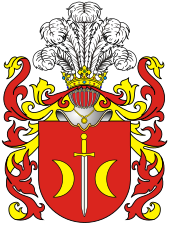The Kałłа́ur family (Polish: Kałłaur; Belarusian: Калавур, Kalavur; Russian: Каллаур) is a szlachta family originating from the Grand Duchy of Lithuania.[1]
| Kałłaur | |
|---|---|
 | |
| Current region | Belarus |
| Place of origin | Pinsk, Grand Duchy of Lithuania |
| Estate(s) | Nechatovo, Kałłaurowicze, Osowce, Wujwicze |
History
editThere are two theories regarding the origin of the surname. In the 14th century, Grand Duke Vitaūt founded the fortress of Kalavur (Karawol, Kalavur, Kalaur) to protect the southern borders of the Grand Duchy of Lithuania. Officials could add the name of the fortress to their names in an adjectival form. For example, according to one version, Nychko Karavulsky did so in the early 15th century.[2] The castle fell into disrepair in the 16th century. In the same century, the Kallaurs obtained government positions in the Principality of Pinsk. According to another theory, the family has Tatar roots (turk. karaul - a guard post). This theory was put forward by the historian Roman Goroshkevich (1892-1962) in his book "List of Noble Families of the Borderland of the Pinsk Region".[3]
The earliest written mention was dedicated to Pinsk boyar and official Chviedzka Lienkavič Kałaur. He concluded a land-sale contract with a royal servant, Orest Kyhir, in 1521.[4][5] The members of the family took part in the Army census of the Grand Duchy of Lithuania in 1528-1567, which underlined their status. Chviedzka Lienkavič and Dzianis Korewulovič participated in the 1528 census as a mounted knights.[6] Four members were numbered among the cavalry within the 1567 census: an officer of the court in Pinsk, Pronko Dzianisavič, Radko Siamionavič, Dałmat and Ivan.[7]
The estate Kałłaurowicze, where the local branch of the household settled, was mentioned for the first time in 1567. The family played an important role in the region. For instance, Piotr Kałłaur was elected as a representative of the nobility of the uyezd of Pinsk in 1853.[8] The members of the family supported the January Uprising in 1863–1864. The monument in honor of the rebels Vasil, Siamion Kałłaur and Anton Šałamicky was opened near Pinsk in 1933.[9]
Some members of the family were subjected to repression in the 1940-1950s. According to the open lists, 7 people were persecuted in the Pinsk Region of the Belarusian SSR.[10][11]
Notable people with surname Kałłaur
edit- Chviedzka Lienkavič Kałaur, XV c.—after 1567, boyar, Pinsk landowner, official and military.
- Vasily Kallaur, 1838–1919, chief of Aulie-Ata uyezd, archaeologist and orientalist.[12]
- Mikołaj Kałłaur, 1920-2017, Polish military person, diplomat and essayist.
- Pavel Kallaur, b. 1962, Belarusian economist and head of the National Bank of Belarus.
References
edit- ^ Алфавитный список дворянским родам Минской губернии, внесенным в дворянскую родословную книгу по 1-е июля 1903 года с приложением списка губернским и уездным предводителям и депутатам дворянства, а также секретарям депутатского собрания. Минск: Губернская Типография. 1903. p. 47.
- ^ Ukraina Lithuanica: студії з історії Великого князівства Литовського (PDF). Київ: Інститут історії України НАН України. 2019. p. 162.
- ^ Horoszkiewicz, R. Spis rodów szlachty zaściankowej ziemi pińskiej. — Warszawa, 1937. — S. 21.
- ^ Писцовая книга бывшего Пинского Староства составленная по повелению короля Сигизмунда Августа в 1561-1566 годах Л. Войною (С переводом на русский язык) Ч. 2. Вильна: Типография А. Н. Зака. 1874. p. 338.
- ^ Ревизия пущ и переходов звериных в бывшем Великом Княжестве Литовском с присовокуплением грамот и привилегий на входы в пущи и на земли, составленная Старостою Мстибоговским Григорием Богдановичем Воловичем в 1559 году с прибавлением другой актовой книги, содержащей в себе привилегии, данные дворянам и священникам Пинскаго повета, составленной в 1554 году. Вильна: Типография Губернского правления. 1867. p. 314.
- ^ Перапіс войска Вялікага княства Літоўскага 1528 года. Метрыка Вялікага княства Літоўскага. Мінск: Беларуская навука. 2003. p. 151.
- ^ Русская историческая библиотека. Том 33. Литовская метрика. Отдел 1. Часть 3: Книги публичных дел. Переписи войска Литовского. Петроград: Типография Главного Управления Уделов. 1915. pp. 614, 617.
- ^ Алфавитный список дворянским родам Минской губернии, внесенным в дворянскую родословную книгу по 1-е июля 1903 года с приложением списка губернским и уездным предводителям и депутатам дворянства, а также секретарям депутатского собрания. Минск: Губернская Типография. 1903. p. 157.
- ^ "Echa Polesia" No.1(37). — Brześć, 2013. — S. 24.
- ^ Indeks Represjonowanych. — Instytut Pamięci Narodowej. — Tryb dostępu: http://www.indeksrepresjonowanych.pl/int/wyszukiwanie/94,Wyszukiwanie.html.
- ^ Жертвы политического террора в СССР. — Международное общество "Мемориал". — Режим доступа: http://lists.memo.ru/index11.htm.
- ^ Лунин, Б. В. Из истории русского востоковедения и археологии в Туркестане. Туркестанский кружок любителей археологии (1895–1917 гг.). — Ташкент, 1958. — 318 с.